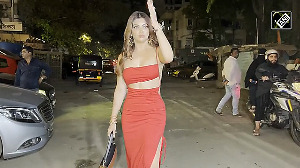First of these, the October 12 Bombay high court order that asks for the wall around the Siddhi Vinayak temple to be demolished. Now this wall was first conceived after the assault on the Akshardham temple in Gujarat a few years ago. Security experts felt that there was a perception of threat to major temples in the country, Siddhi Vinayak being one. Thus the idea to build a wall around the temple.
As far as I can tell, the original plan was to build it at a distance of 8 feet from the temple. As these things invariably seem to go, that 8 feet had morphed to 60 feet (no typo, 60 feet) when the wall was completed a year ago.
As anyone who has been in that part of Bombay knows, there are a lot of pedestrians there. Some of them, of course, are visitors to the temple: late on any Monday night, for example, you will find streams of barefoot pilgrims walking long miles, to be at Siddhi Vinayak on Tuesday. But some of the pedestrians are just that, pedestrians.
Citizens walking from home to shop to bus-stop to street vendor, all of which there are in abundance in the area. There is even a small park near the temple, and one of the city's major cultural centres just beyond. Yes, a LOT of pedestrians.
And if it sees a lot of pedestrians, it sees plenty of cars and buses too. The Siddhi Vinayak junction is a major intersection on the city's main commuting route. At nearly any time of day, there are long lines of traffic waiting at the signal. The right angle turn the road makes just south of the temple serves to make the traffic right there -- next to the temple, alongside the wall -- even heavier.
Yet the wall blocks off such a large area that there is no space for pedestrians any more on that stretch, which -- as you may have deduced -- is a serious bottleneck anyway. So what do these walkers do, now that the wall is up?
Simple: they are forced to take their chances with the cars and buses. Yes, they must edge along, sharing the road -- the road! -- with some of the heaviest traffic in the city.
Interesting, don't you think? To stave off a perceived security threat, you subject thousands of people every day to a very real threat to their lives, by making them walk where the traffic rushes.
Residents of the area were the loudest in their opposition to the wall. Nobody listened, and the wall got built over their objections. (As these things seem to go too, the temple people knew that making the wall a fait accompli was the best way to reduce the opposition to futility). So they went to court. And now the high court has ordered the wall demolished. Said Justice Lodha: 'In the name of security, a solid wall cannot be constructed without any authority of law... The wall ultimately restricts the movement of the public."
No wonder these residents welcomed the judgment with sweets and firecrackers. Much more intimately than the rest of us, they know what this is about.
Second of these, the October 17 judgment in the Priyadarshini Mattoo case. I mean, what is there to say about this? To anyone who knew it, the December 1999 judgment in this case was a savage mockery of justice. What else would you call a judgment in which the judge observes: 'The Delhi police attempted to assist [the accused, Santosh Singh] during investigation and also during trial ... [T]he rule of law is not meant for those who enforce the law nor for their near relatives.' (That, because Singh is the son of an ex-police officer).
And: 'Though I know [Santosh Singh] is the man who committed the crime, I acquit him, giving him the benefit of the doubt.' (Which line, I suspect, is now one of the more famous excerpts from any Indian judgment).
The high court judgment that overturns this blatant injustice and convicts Singh is only what we should have seen in the first place, back in 1999. Yet it must be a measure of how inured we are to injustice in this country that we celebrate the new judgment; that it took sustained public outrage in the wake of another great miscarriage of justice -- the Jessica Lal case -- to even get an appeal against the 1999 judgment heard.
So yes, let's celebrate. But let's remember the real lesson of these two events: how difficult it is to get some justice.
I mean, surely the building of a wall should have been done in consultation with the people it would most affect. Instead its presence has endangered people's lives for a year now. It took the high court to find a way out of this mess, at an enormous price in money and resentment. And what's that way out? The demolition of a wall that should never have been built.
Similarly, surely that famous line alone should have been enough in 1999 to order, at a minimum, a fresh investigation into Priyadarshini Mattoo's murder. Instead, it has taken seven years of frustration and heartbreak to convict Santosh Singh.
Justice is done. Or is it?
My column about that 1999 judgment in Priyadarshini Mattoo's case: Few Notice the Terror
---
Death Ends Fun: https://dcubed.blogspot.com






 © 2025
© 2025